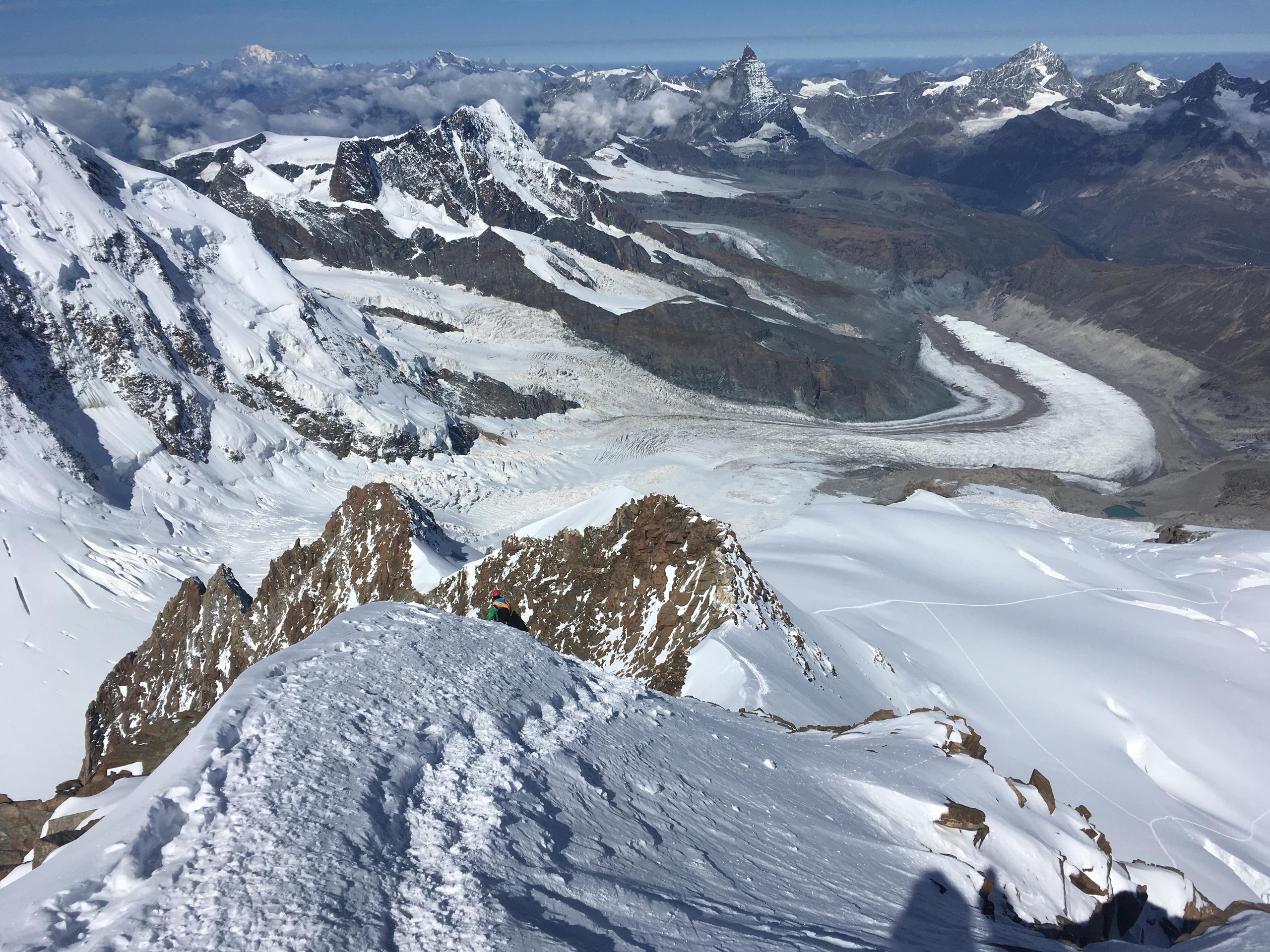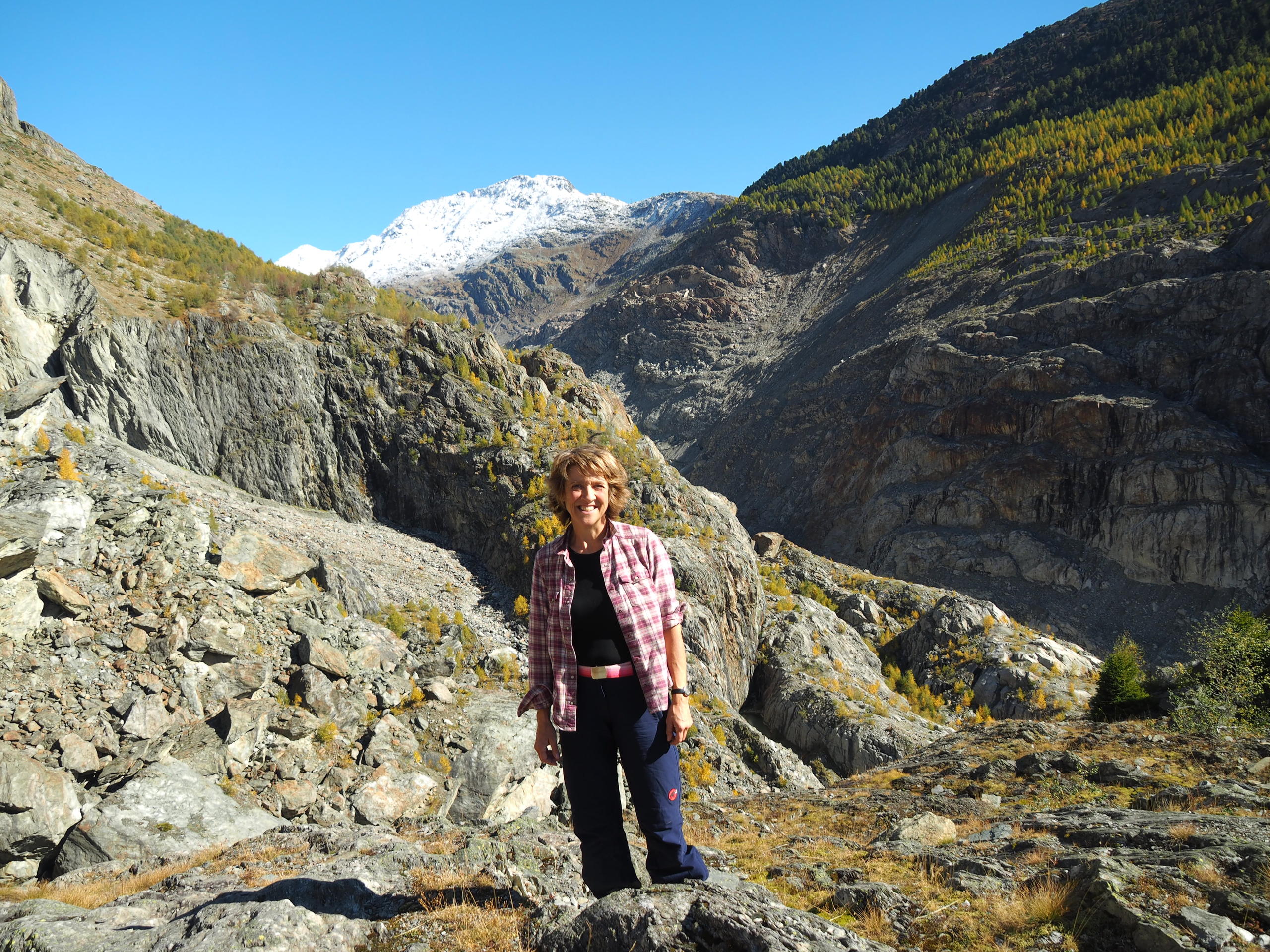
From a wheelchair to climbing mountains
A sufferer of an incurable autoimmune disease, Ankylosing Spondylitis (AS), Judith wrote about coming to terms with her diagnosis in a first post, and in a second, the treatment that allowed her to resume her passion for mountains. Here, she describes her five days on top of the world.
Only 18 months after requiring a wheelchair at the airport, Judith Safford has accomplished her dream of climbing several of Switzerland’s highest peaks – 16 in all – in only five days.
I looked around me. Dazed and disbelieving I saw a sea of fluffy clouds over the Po plain of Italy to the south. It was like being in a plane, except that the landscape stayed still and the cold wind stung my face.
In all other directions, occasional clouds were scattered amid the peaks below me. Between them I could just see down to green valleys, far below. To the north and east huge glaciers wound magnificently down towards the lone summit of Matterhorn, which seem to stretch elegantly but somehow coquettish to the sky. That icon of the Alps was below where I was standing now. Left of the Matterhorn in the distance stood the great massif of Mont Blanc, the only point in western Europe higher than where I was now.

I was standing on the Dufourspitze, also known as Monte Rosa, 4,634m above sea level. It was the 16th 4,000m peak that I had climbed in five days. I had achieved everything that I had wanted to do. The toil of the last months of preparation had paid off. The fear and doubts, the sleepless nights listening to my heart thumping, all disappeared in the sublime beauty of that moment.
I turned to my rope partners and we hugged and congratulated each other, I sobbed tears of gratitude and relief.
We took in the scenery for a few more minutes, took some photos, drank a sip of hot tea from our thermos flasks, forced down some dried fruits or chocolate and then our guide, Roman, said, “Let’s go. Concentrate.” Indeed, we had several hours to go before the tour was safely completed. As everyone who has climbed trees as a child knows, going down is usually more difficult than climbing up.
The final tour
Day 1. Roccia Nera 4075m
Day 2. Pollux 4092m and Castor 4223m
Day 3. Felikhorn 4087m, Lyskamm traverse over the Westgipfel 4479m and Ostgipfel 4527m
Day 4. Punta Giordani 4046m, Piramide Vincent 4215m, Balmenhorn 4167m, Corno Nero 4321m, Ludwigshöhe 4341m, Parrotspitze 4432m, Signalkuppe 4554m
Day 5. Zumsteinspitze 4563 m, Dunantspitze 4632m, Dufourspitze 4634m
Nothing but a step
On the summit of Monte Rosa there is plaque commemorating the first ascent in 1855 with a quote by Seneca, “What you think to be the peak is nothing but a step.” Taking ‘nothing but a step’ had been my driving force during the last days. The tours had been long – up to 12 hours – and if a particular slope had seemed endless and I had felt that there was no way that I could muster the strength to continue, I just concentrated on taking a step. Eventually one of those steps was indeed the summit. Indeed, this idea of taking one step at a time has been an important element of managing my life generally since the diagnosis of Ankylosing SpondylitisExternal link.
Roman’s frequent reminder to concentrate was also about taking steps. Many of the peaks we had ascended were along thin ridges, where steep slopes fall away for perhaps 1,000m on both sides. A fall would mean almost certain death. So, the only safe way to proceed is to walk exactly on the top of the ridge, so that if someone did stumble and fall on one side, another rope partner can jump in the other direction down the other and thus break the fall. Naturally, this is only a measure of last resort.
The best way forward is to concentrate all your senses on every single step, take even, perfectly placed paces, feel how your rope partners are moving and coordinate your movements with them.
On day two we crossed the Lyskamm, one of the classical traverses in the Alps. The West peak is 4491m ascending slightly to the East peak at 4527m. It is an exposed ridge stretching for about 2km with stunning views, as if suspended in space over its north face. I love the awareness that such situations create. I feel alive and confident in my abilities, knowing that I am no more likely to stumble as I would when going downstairs at home.

Only on the last day, very early in the morning on an icy traverse between Zumsteinspitze (4452m, 14th peak) and Dunantspitze (4632m, 15th peak) did I become fearful and start thinking about my family. I immediately had to remind myself, that this did not serve my purpose, and I must focus entirely on the task at hand – making a safe step.
Why I love mountaineering
These mental demands are part of the fascination of mountaineering for me. Climbers require very balanced skills. They need finely honed techniques, physical strength and endurance and a strong mental focus. The importance of the overall mental challenge should not be underestimated.
Our group of four was led by two mountain guidesExternal link, so that the crucial elements of risk management, planning and decision making were delegated to experienced professionals. Nevertheless, even with this support the ability to overcome fear, to concentrate completely on the task at hand and master the challenges presented is essential to success.
During the tour, I experienced many moments of doubt. I was surprised and worried about how tired I was already after day two. I was very nervous of the technical challenges of the Lyskamm on day three, and the long fourth day which included no fewer than seven 4,000m peaks. On that morning, I felt too tired to eat much and my legs were like lead after only an hour or two of walking. Luckily with the guides’ support, some rye bread, dried meat and cheese topped up with tea helped stabilise my condition. I felt much better after a couple of hours. But my doubts about whether I could complete the tour continued even into day five.
Treating Ankylosing Spondylitis
People have always suffered from rheumatic diseases. My mountaineering success is mainly due to an effective combination of medications to treat my AS. Unfortunately, the combination of two substances that make up my treatment is not yet recommended by ASAS (Assessment of SpondyloArthritis International Society) or EULAR (European League Against Rheumatism), because there has not been sufficient evidence presented to show that the treatment works. The result is that many people do not receive this treatment.
A further restriction are the high costs and unknown long-term risks of treatment, which means that it is not freely prescribed. Finally, only a small proportion of arthritis patients are helped by the medication I receive – for most others there are only symptomatic therapies, such as anti-inflammatory and other painkillers or joint replacement. Musculoskeletal disorders is the disease group responsible for the highest combined direct and indirect health costs (more than CHF20 billion per year) of all non-communicable diseases in Switzerland. I wonder why arthritis research receives so little attention?
My climbing achievement despite AS shows that medical treatments are now available to help people affected by arthritis to live full lives. But at present only a privileged few are benefiting. More research is needed to find treatments that work for all people affected by rheumatic diseases. Too little research is done – to relieve suffering, to prevent and ultimately to cure.
The mountain hut experience
We spent the night of day four on the Signalkuppe at 4554m. The Italian Alpine Club (CAI) has built a mountain hut right on top of the summit, called La Capanna Regina Margherita. Even if you are well acclimatised, that is a very high place to sleep. At this altitude, the oxygen content of the air is almost half what it is a sea level. The body cannot recuperate as it would be able to at lower altitude.
Needless to say, mountain huts are not typically very comfortable places. Beds are in tightly packed dormitories. You can purchase a limited selection of food and drinks. Accommodation includes a set evening meal and breakfast offered between about 4 and 8am, depending on when your planned tour starts. Water is usually only available for washing in cold and limited quantities.

The Capanna Regina Margherita has no water supply at all. If you think about it, it’s not surprising, because where would you get water on a mountain summit? The toilet is a small tin clad room with a hole in the floor. There is hospital antiseptic concentrate to clean your hands.
All in all, I didn’t feel much like eating, but we sat down to the most stunning meal that I’ve eaten for a long time: a carrot and ginger soup garnished with a deep fried, crispy topping, then a salad of different tomatoes and burrata, then two sorts of pasta with aubergines and sweet red pepper. The main dish was roast lamb infused with garlic and copious quantities of rosemary on a bed of crisp, but perfectly cooked cabbage, accompanied by Italian fried potatoes. Oh, and I almost forgot the beetroot salad! For dessert there were shortcake biscuits, little black and white chocolate coins and water melon. It was probably one of the most wonderful and surreal experiences of my life. I believe that it helped me to manage the final day!
What next?
As I write this, I am still somehow in a trance. I haven’t really understood what happened. I can’t really believe that I managed to climb 16 4,000m peaks in five days, when a little over 18 months ago, I needed a wheelchair service to travel to London because I could barely walk.
What is Ankylosing Spondylitis?
Ankylosing Spondylitis or AS for short (known as Morbus Bechterew in German and French) is a painful inflammatory stiffening of the spinal column for which there is no known cure. Although it mainly affects the spine, it can impact other joints as well. Stiffness of the affected joints generally worsens over time. In more advanced cases the inflammation can lead to ankyloses – which causes sections of the spine to fuse in a fixed, immobile position. (sources: Swiss Ankylosing Spondylitis Association, Spondylitis Association of America, Wikipedia)
The views expressed in this article are solely those of the author, and do not necessarily reflect the views of swissinfo.ch.

In compliance with the JTI standards
More: SWI swissinfo.ch certified by the Journalism Trust Initiative
































You can find an overview of ongoing debates with our journalists here . Please join us!
If you want to start a conversation about a topic raised in this article or want to report factual errors, email us at english@swissinfo.ch.